A puppy training schedule template can help you structure your dog’s training program and ensure that it is consistent and effective. This article will discuss how to create a perfect puppy training schedule template.
Bringing a new puppy home is a joyful experience. But with it comes a lot of responsibilities. One of the most critical things you must do is train your puppy correctly. A puppy training schedule template can help you with that. It is an effective way to structure your dog’s training program and ensure consistency and effectiveness. Will examine how to create a perfect puppy training schedule template.
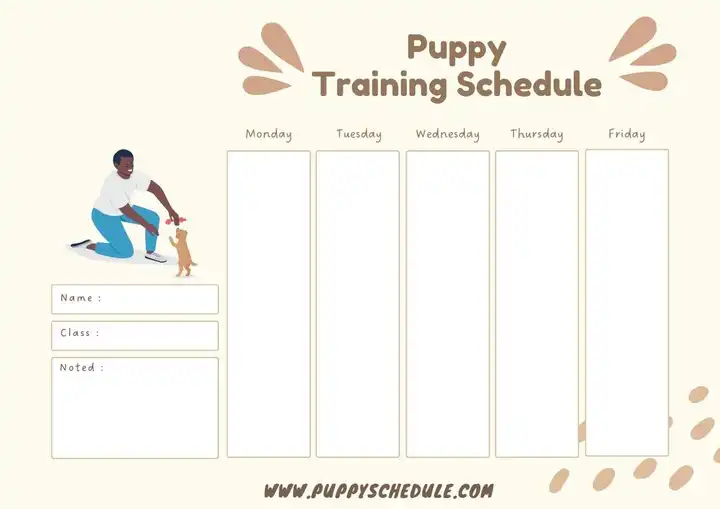
Why Do You Need a Puppy Training Schedule Template?
He is some reason why You need it:
Helps in Consistency
One of the most critical elements of training a puppy is consistency. A puppy training schedule template can assist you in staying on track with your exercise program. It ensures that you cover all the necessary topics and that your puppy gets attention and practice.
Structure the Training Program
A well-structured training program is critical for the success of your puppy’s training. A puppy training schedule template helps you organize and structure your training program logically and systematically.
Time Management
Creating a puppy training schedule template can help you manage your time effectively. It allows you to organize training sessions at convenient times that function for you and your puppy.
How to Create a Puppy Training Schedule Template?
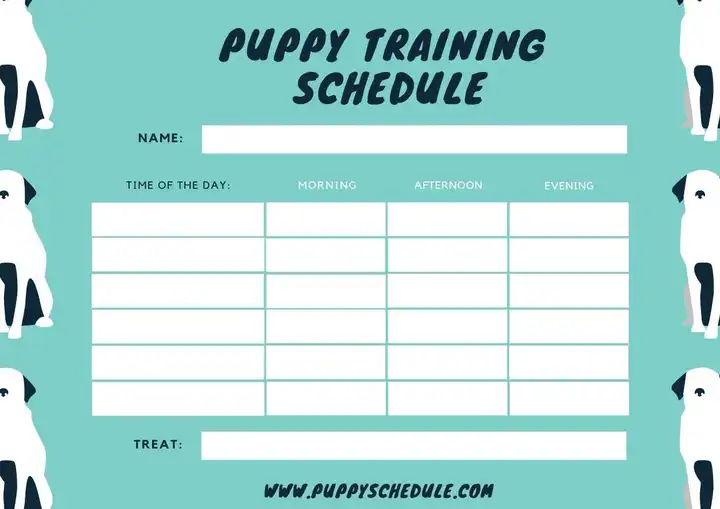
He stepped in, creating for making it easy.
Determine the Training Objectives
The first step in creating a puppy training schedule template is determining the training objectives. Decide what you want to achieve in the training program, such as potty training, obedience training, and socialization.
Divide the Training into Segments
Divide the training into basic commands, house training, and socialization. This will help you focus on one area at a time and guarantee that your puppy reaches enough practice before moving on to the next segment.
Schedule the Training Sessions
Schedule the training sessions at a convenient time that performs for both you and the puppy. Determine the frequency and duration of each training session. Remember to keep the training sessions short and sweet to save your puppy engaged and motivated.
Include Playtime and Rest Time
Include playtime and rest time in the puppy training schedule template. Puppies need plenty of rest and playtime to stay healthy and happy. Ensure to include breaks in the training program, so your puppy can stay energized and energized.
Common Mistakes to Avoid When Training Your Puppy
Here are the top five mistakes to avoid:
- Not enough exercise – A puppy needs plenty of physical activity to be happy and healthy. If they’re not getting enough, they may become destructive or disobedient.
- Ignoring their basic instincts – Puppies have an instinctual drive to explore and learn new things, which can get them into trouble if you don’t let them do it safely. For example, puppies might try to chew on electrical cords or dig through trash cans looking for food. Set boundaries around these activities early on so your pup doesn’t develop bad habits later in life.
- Reacting instead of responding positively – When your pup does something wrong, always respond positively rather than negatively; this will help build trust between you and encourage good behavior in the future.” “
- Using punishment instead of positive reinforcement – Praise is always better than rewards when training a dog because it teaches them that good behavior is its reward.
- Neglecting socialization – Puppies need exposure to people and other animals from a young age to feel comfortable with humans later in life.”
Tips for Successful Puppy Training
Here are some tips for training:
- Start training early – Puppies know best when they’re young, so start training them on fundamental obedience skills as soon as you bring them home. This will assist in building their confidence and setting good habits from the get-go.
- Use positive reinforcement – Honoring your puppy when they obey commands is one of the most effective training methods. Not only will this cause them to feel appreciated, but it will also encourage future behavior in the same direction.
- Be consistent – It’s important to keep your training sessions short and frequent enough to remember what was taught earlier but not so frequently that puppies become bored or frustrated (which could lead to negative behaviors).
- Keep training sessions brief – A typical dog-training session should last no more than 15 minutes total, which is long enough for basic obedience lessons but not so long that puppies get restless or tired out (and may resist learning anything new).
- Be patient – While puppies understand fast if given proper encouragement and guidance, sometimes things take longer than expected – especially at first! Don’t get discouraged; patience is key to any successful endeavor.
The importance of consistency in training and how it can impact the success of the training.
The utmost significance of consistency in training and how it can have a colossal impact on the success of the training cannot be overstated. As puppy training can be arduous, it requires persistent and unwavering effort. Consistency is paramount in training and can determine the success of the training.
So, what exactly is consistency in training?
Consistency in training involves utilizing the same techniques and commands each time you train your puppy. Establishing a routine and sticking to it when training a puppy is crucial. Consistency allows your puppy to understand what is expected of them, ultimately leading to a more successful training experience.
Why is consistency so vital in training?
Consistency is critical in helping your puppy learn faster and comprehend new behaviors and commands. By consistently using the same techniques and commands, your puppy will understand what is expected of them. This understanding can speed up learning, resulting in more desirable behavior and better obedience.
Consistency also fosters trust and confidence between you and your puppy.
Your puppy will feel secure and confident in their environment by remaining consistent with your training methods. This confidence can make the training experience more successful, leading to better behavior and obedience.
Inconsistent training can confuse your puppy.
If you employ different techniques or commands each time you train, your puppy may require clarification or assistance to learn the desired behavior. This confusion can lead to frustration and hamper the training process.
Consistency in training also creates a routine for your puppy.
A routine can help your puppy feel more comfortable and secure in their surroundings. This comfort can lead to better training outcomes, as your puppy will be more responsive to learning new behaviors and commands.
Consistency is crucial in maintaining good behavior in your puppy.
Positive reinforcement and rewarding good behavior consistently will make your puppy more likely to repeat that behavior. This repetition can lead to the development of good behavior and a well-trained adult dog.
Consistency is an essential component of successful puppy training. Staying consistent with your training methods and commands can help your puppy learn faster, build trust and confidence, prevent confusion, create a routine, and maintain good behavior.
How to troubleshoot common problems during puppy training?
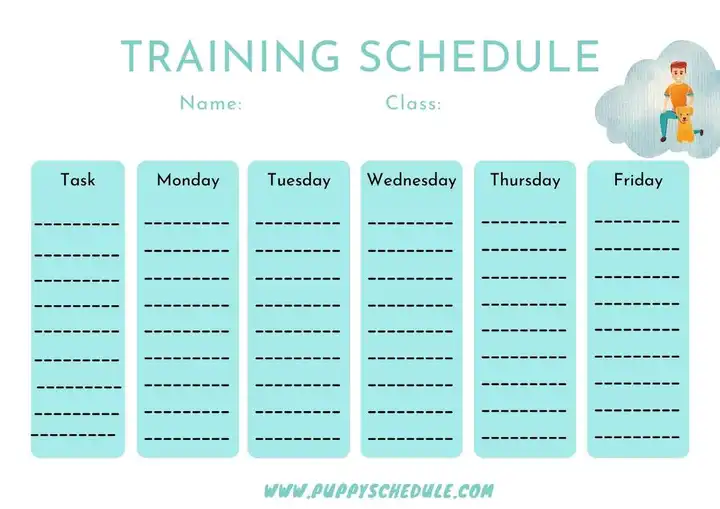
There are solutions to these common problems that can turn your training woes into a fun-filled experience.
Biting
Biting is a natural behavior for puppies, but it can be problematic if it escalates into aggressive behavior. To nip this issue in the bud, try redirecting your pup’s attention to a chew toy or bone, using positive reinforcement by rewarding them for not biting, and encouraging gentle play to teach bite inhibition.
Barking
Barking can also be frustrating during training, and excessive barking can cause chaos in your household. Identifying the underlying cause of the barking, whether it’s boredom or anxiety, can help address the problem. You can also teach your puppy the “speak” and “quiet” commands, using positive reinforcement, to reinforce good behavior.
Leash pulling
Leash pulling is another common problem that can disrupt your puppy’s training. It’s essential to train your puppy to walk calmly on a leash to avoid pulling. A no-pull harness can discourage your pup from pulling, while rewarding them for walking calmly on a leash can encourage good behavior. Stopping when your puppy pulls can also teach them that pulling is unacceptable.
How to make training sessions fun and interactive
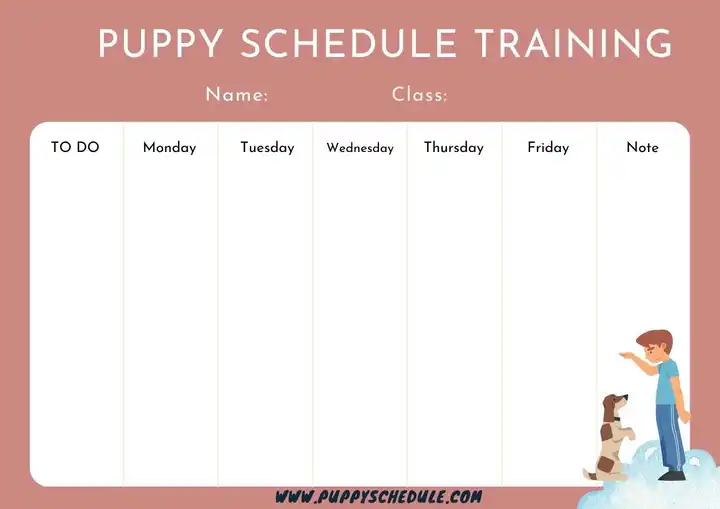
Puppy training is a process that starts with getting your new puppy used to people and other animals and then progressed to basic obedience commands. The training goal is for you and your pup to have fun while learning important skills.
Several common mistakes made during puppy training sessions can make them less enjoyable for both of you, leading to frustration and failure on your pup’s part. Here are seven tips designed to help avoid these pitfalls:
- Use Positive Reinforcement: When puppies exhibit good behavior, offer positive reinforcement through praise, treats, or toys. This will help establish a positive association between good behavior and rewards, which will encourage future behaviors from your pup.
- Keep Sessions Short: Puppies learn best when they’re kept short sessions focusing on one specific task at a time. This helps prevent boredom and confusion among the dog/pup team, making it easier for everyone to learn new things quickly.
- Be Consistent: Training should be consistent across all situations (home/away), times (morning/night), and members of the family (males/females). Being inconsistent can lead to confusion about what’s expected from either party.
- Use Games: Playing games together during training sessions keeps things interesting for you and your pup and teaches valuable obedience skills such as problem-solving & spatial awareness.
- Keep it Positive: Puppies learn best when enjoying themselves, so ensure the training environment is one that puppies will enjoy. Play music, use toys that engage you and the puppy, and keep things moving by mixing up the location and activities each time you train.
- Take Breaks: Puppies need breaks just like adults do – even during training! If your pup gets too worked up or restless, take a break for 10 minutes or so to give them time to calm down before continuing. And always remember to praise them enthusiastically when they comply with instructions!
- Vary the Training Location: When teaching basic commands such as “sit,” “stay,” or “come,” try different locations in your home – on furniture, in front of curtains, near other animals – until you find an area where your pup is consistently obedient. And don’t forget about verbal cues; using words instead of physical punishment can help reinforce good behavior over time.
How to track progress and make adjustments
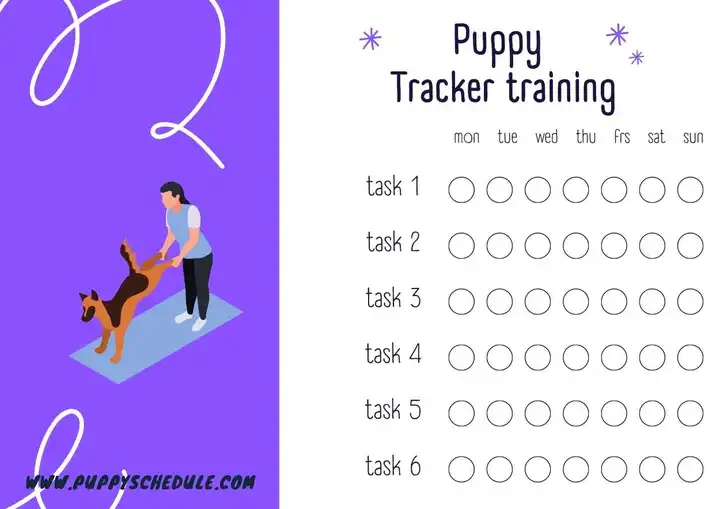
Puppy training can be a lot of work, but it’s important to keep track of your progress to know what needs to be done and when. Here are four tips for doing just that:
- Use a training log: A training log is a great way to track the progress of your puppy’s development and make adjustments as needed. You’ll have an accurate record of your pup’s growth and development by recording everything from when you start training to what behaviors have been corrected.
- Evaluate your puppy’s behavior: After every session, evaluate how well your pup behaved and make adjustments as necessary. This will help you determine which areas need more attention and which can wait until later in the Training Process).
- Adjust the schedule as needed: As your pup becomes more proficient at obedience commands, you may find that less frequent sessions are required for them to retain those skillset s. If this is the case, adjust the frequency of future sessions accordingly by marking them on your calendar or using an app like Dog Trainer Pro.
- Seek professional help: If things seem too difficult or frustrating for you or your dog, consider seeking professional help. A qualified trainer will guide each stage of Puppy Training while monitoring overall success rates.
By tracking progress and adjusting the training schedule as needed, you can ensure that your puppy is receiving the necessary training to develop into a well-behaved and well-adjusted adult dog.
Frequently Asked Questions
How long should a training session last?
A training session should last between 10 and 15 minutes for puppies. Short, frequent training sessions are more effective than longer sessions.
How often should you train a puppy?
You should instruct for at least 15 minutes three times a day. Schedule training sessions at a convenient time that works for you and your puppy.
What should be included in a puppy training schedule template?
A puppy training schedule template should include the training objectives, segments of training, frequency, and duration of each training session, playtime and rest time, and progress tracking.
Conclusion:
Creating a puppy training schedule template can help you structure your training program and ensure that it is consistent and effective. It is an excellent way to manage your time and focus on critical training areas. Use this guide to create a perfect puppy training schedule template and enjoy a happy


